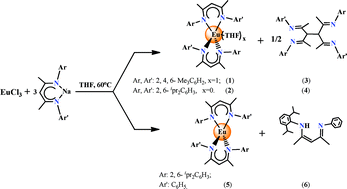Reduction of Sterically Hindered β-Diketiminato Europium(iii) Complexes by the β-Diketiminato Anion: A Convenient Route for the Synthesis of β-Diketiminato Europium(ii) Complexes†
Abstract
The

* Corresponding authors
a
Key Laboratory of Organic Synthesis of Jiangsu Province, College of Chemistry, Chemical Engineering and Materials Science, Soochow University, Suzhou, People's Republic of China
E-mail:
qshen@suda.edu.cn
Fax: +86-512-65880305
b State Key Laboratory of Organometallic Chemistry, Shanghai Institute of Organic Chemistry, Chinese Academy of Sciences, Shanghai, People's Republic of China
The

 Please wait while we load your content...
Something went wrong. Try again?
Please wait while we load your content...
Something went wrong. Try again?
X. Shen, Y. Zhang, M. Xue and Q. Shen, Dalton Trans., 2012, 41, 3668 DOI: 10.1039/C2DT12176J
To request permission to reproduce material from this article, please go to the Copyright Clearance Center request page.
If you are an author contributing to an RSC publication, you do not need to request permission provided correct acknowledgement is given.
If you are the author of this article, you do not need to request permission to reproduce figures and diagrams provided correct acknowledgement is given. If you want to reproduce the whole article in a third-party publication (excluding your thesis/dissertation for which permission is not required) please go to the Copyright Clearance Center request page.
Read more about how to correctly acknowledge RSC content.
 Fetching data from CrossRef.
Fetching data from CrossRef.
This may take some time to load.
Loading related content
